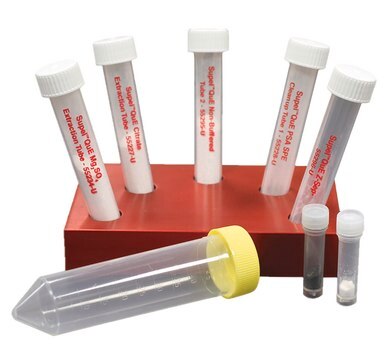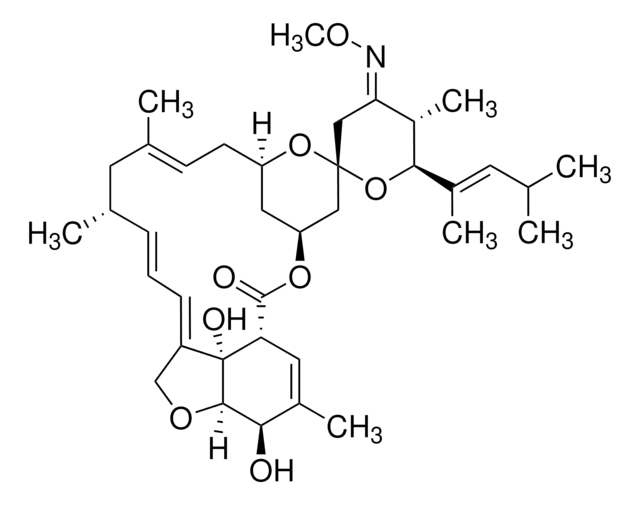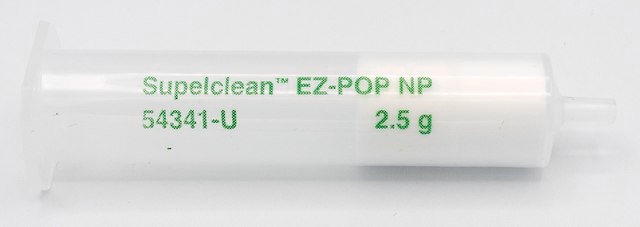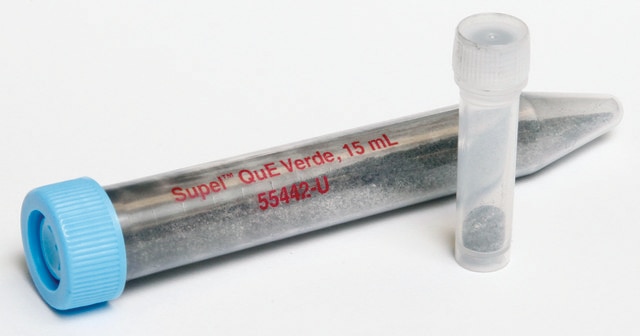55227-U
Supel™ QuE QuEChERS tube
Citrate Extraction Tube, pk of 50, suitable for EN 15662
Synonym(e):
QuEChERS
About This Item
Empfohlene Produkte
product name
Supel™ QuE, Citrate Extraction Tube, pk of 50, suitable for EN 15662
Materialien
polypropylene tube
Qualitätsniveau
Agentur
suitable for EN 15662
Produktlinie
Supel™
Zusammensetzung
magnesium sulfate, 4 g
sodium chloride, 1 g (Cat. No. S7653)
sodium citrate dibasic sesquihydrate, 0.5 g (Cat. No. 71635)
sodium citrate tribasic dihydrate, 1 g (Cat. No. S4641)
Verpackung
pk of 50
Methode(n)
QuEChERS: suitable
Zentrifugenröhrchenvolumen
15 mL
Anwendung(en)
food and beverages
Trenntechnik
ion exchange
Suchen Sie nach ähnlichen Produkten? Aufrufen Leitfaden zum Produktvergleich
Verwandte Kategorien
Allgemeine Beschreibung
Mit dem QuEChERS-Verfahren werden die Proben (Nahrungsmittel oder landwirtschaftliche Erzeugnisse) zunächst in Gegenwart von großen Mengen Salzen (z. B. Natriumchlorid und Magnesiumsulfat) und/oder Puffermitteln (z. B. Citrat) mit einem wässrigen, mischbaren Lösungsmittel (z. B. Acetonitril) extrahiert, um die Separation der Flüssigphase zu induzieren und säure- bzw. basenlabile Pestizide zu stabilisieren. Nach Schütteln und Zentrifugierung wird ein Aliquot der organischen Phase einer weiteren Reinigung mittels SPE unterzogen. Anders als bei herkömmlichen Methoden, bei denen SPE-Röhrchen genutzt werden, erfolgt die Reinigung bei der dispersiven SPE durch Mischen von SPE-Großmengen (z. B. Supelclean PSA, ENVI-Carb und/oder Discovery DSC-18) mit dem Extrakt. Nach der Probenreinigung wird die Mischung zentrifugiert; das Ergebnis ist ein Überstand, der entweder direkt analysiert oder vor der Analyse weiterer geringfügiger Behandlung unterzogen werden kann.
Supelco bietet eine Produktlinie von Flaschen und Zentrifugenröhrchen mit vorportionierten Mengen von Salzen und SPE-Sorptionsmitteln, um die aktuell am häufigsten verwendeten Methodenkonfigurationen zu unterstützen.
Anwendung
Eignung
Rechtliche Hinweise
Anwendung
Erforderlich, aber nicht bereitgestellt
WGK
WGK 1
Flammpunkt (°F)
Not applicable
Flammpunkt (°C)
Not applicable
Choose from one of the most recent versions:
Besitzen Sie dieses Produkt bereits?
In der Dokumentenbibliothek finden Sie die Dokumentation zu den Produkten, die Sie kürzlich erworben haben.
Kunden haben sich ebenfalls angesehen
Artikel
Compared to conventional PSA/C18/GCB cleanup, cannabis extracts cleaned with the Supel QuE Verde mixture showed lower GC/MS background, and better recoveries for many pesticides.
The comparison of Supel™ QuE Z-Sep/C18, PSA/C18, and PSA QuEChERS sorbents, in terms of color removal and analyte recovery, is described for the cleanup of oranges prior to pesticide analysis.
Pistachios contain approximately 45% fat, which can result in a significant amount of coextracted matrix in the acetonitrile extract generated using the QuEChERS procedure. A zirconia based adsorbent significantly reduces coextracted matrix prior to LC-MS or GC-MS.
Pesticide residue testing of turmeric and other (dried) spices is challenging due to their complex compositions and high matrix. An efficient SPE clean-up can be achieved by a new Dual-layer cartridge.
Protokolle
A highly selective and sensitive analytical method was developed for chloramphenicol using a QuEChERS type sample preparation approach and LC-MS/MS detection.
Verwandter Inhalt
QuEChERS method simplifies sample cleanup for pesticides analysis in food and agricultural samples.
QuEChERS is a ‘Quick, Easy, Cheap, Effective, Rugged and Safe’ sample cleanup method used to prepare food and agricultural samples for pesticides analysis. QuEChERS is based on the Solid Phase Extraction (SPE) technique of sample preparation.
Solid phase extraction purifies samples for chromatographic analysis, improving data quality and protecting analytical columns.
Chromatograms
application for HPLCapplication for HPLC, application for SPEUnser Team von Wissenschaftlern verfügt über Erfahrung in allen Forschungsbereichen einschließlich Life Science, Materialwissenschaften, chemischer Synthese, Chromatographie, Analytik und vielen mehr..
Setzen Sie sich mit dem technischen Dienst in Verbindung.



